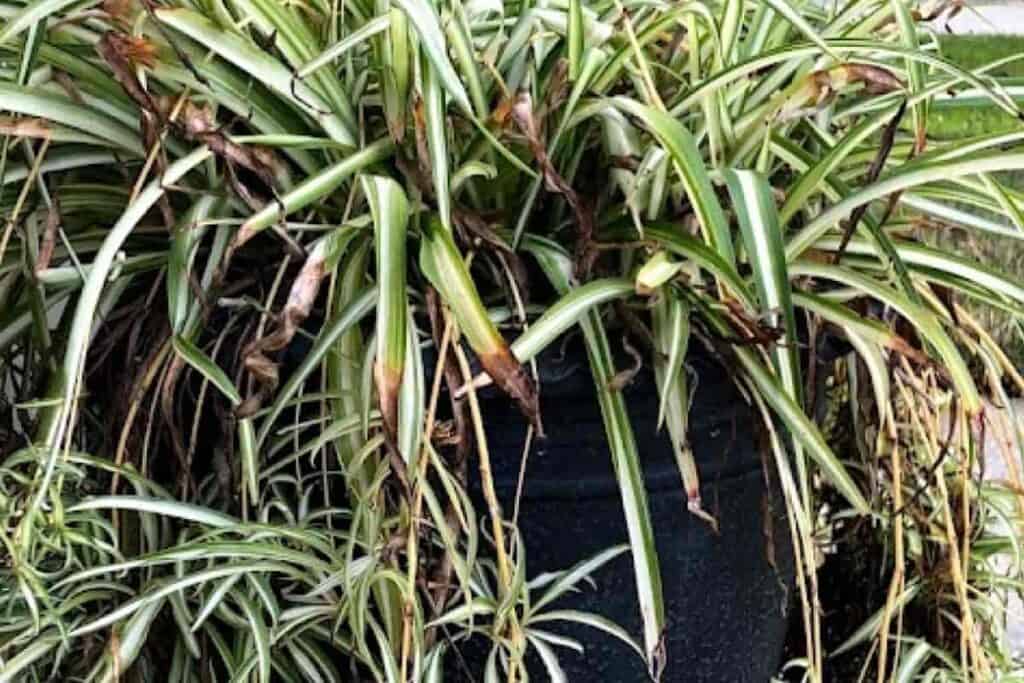Chlorophytum comosum (kloh-roh-FY-tum kom-OH-sum) is one of the most resilient plants out there. So when something goes wrong, it can catch you off-guard.
These natives of South Africa were one of the first plants tested by NASA for air purification qualities. They are a favorite of homeowners due to their easy care and non-toxicity to cats and dogs.

But, your spider plant can get sick, and two of the most common symptoms are yellow or brown leaves.
Yellow leaves can signify something potentially serious, so it’s important to find the cause quickly.
Why Is My Spider Plant Turning Yellow?
Yellow leaves can be a sign of pest problems, disease, or care deficiencies.
Check for each problem so you can take care of it as soon as you notice yellowing to avoid lasting injury to your plant.
Problem #1: Pest Issues
One of the reasons spider plant owners notice yellowing leaves is a pest infestation.
Several pests attack spider plants, such as aphids, mealybugs, and spider mites.
These pests hide on the undersides of leaves and pierce the surface. They drain the sap and leave deposits of honeydew, which can lead to powdery mildew and other problems.
You can use neem oil, hydrogen peroxide, or another pet-safe, natural product to get rid of the infestation so your plant will be able to heal.
Problem #2: Disease
Discoloration of spider plant leaves is often the first warning sign of an infection.
The most infamous of these diseases is root rot, a fungal infection resulting from too much water.
Failing to treat the rot quickly can kill your plant, so it’s important to use treatments if you believe you’ve been overwatering the plant.
The best treatments are a neem drench or soak, neem cakes, and hydrogen peroxide drenches.
Problem #3: Care Deficiencies
Even though they’re not picky, the most common reason spider plant leaves turn yellow is too much or too little care.
The following factors can all cause leaf yellowing and are usually easy to remedy.
Light
Your spider plant can handle a wide range of lighting conditions, from shade to bright light.
Avoid direct sunlight, which can cause sunburn.
The plant will grow more slowly in the shade, and the leaves will darken. But when it gets too much direct sunlight, the leaves can turn yellow.
The yellowing comes from different chloroplast types in the leaves reacting to a specific kind or degree of light while it attempts to get the optimal amount of light for photosynthesis.
When too much light is the issue, you can move the plant to a location with more indirect light.
You can also occasionally rotate the plant to ensure all sides get equal lighting if you notice one side is a darker green than the other.
Moisture
Spider plants prefer low moisture and can turn yellow when there’s too much or too little water.
Stick your finger in the soil to check the dryness.
The first 1″ to 2” inches of soil should be damp to the touch, and it’s best to water when the top inch of soil is almost dry.
If you encounter dry soil, your plant is probably dehydrated.
Likewise, having too much water can cause yellowing and may lead to root rot.
If the soil is still moist or your pot has poor drainage, you’ll want to reduce how often you water your spider plant.
Remember, spider plants are somewhat drought tolerant and can withstand low humidity levels, so too little is better than too much.
The best thing is to set a consistent watering schedule to ensure you water indoor plants when they need it.
This simple method can prevent overwatering or underwatering. Keep the soil moist as needed with a spritz or two of water from a spray bottle between scheduled waterings.
Finally, there may be an issue with the quality of the water you’re using.
Tap water contains many chemicals that can be harmful to plants. Switch to distilled water when it’s time to water the plant again.
Soil and Food
Good potting soil is usually all your spider plant needs. Too much fertilizer or high salt levels can result in chemical burns and yellow leaves.
To avoid salt buildup, excess minerals, and ensure your plant’s soil has enough nutrients to maintain the plant’s health, repot or replace the soil each spring.
Another benefit of repotting is to reduce binding. Spider plants don’t mind being root-bound, but this can slow growth and drain the soil of nutrients faster as the root ball fills the pot.